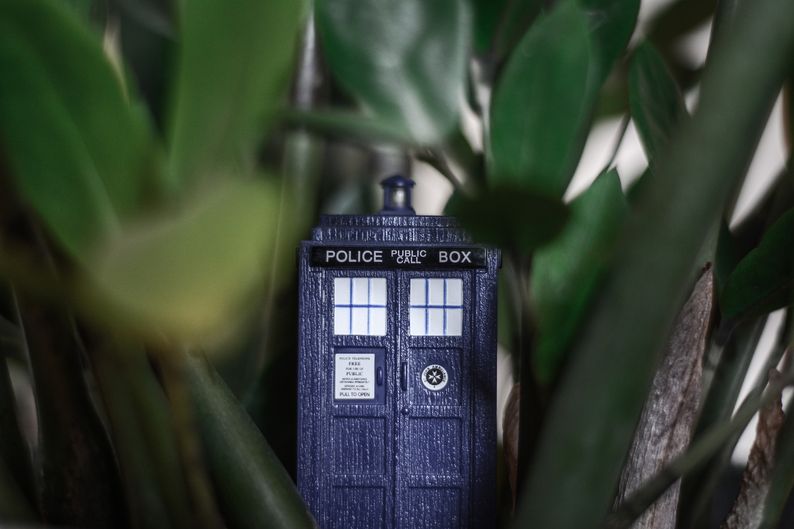
Scarves and Stripes
Estimated Reading Time: 2-3 minutes.
Image: BBC
Dr. Who
PDF Download, 127.1 KB
Click 'Download PDF' to view and/or download this astrological chart.
Download PDFImage: Charlie Seaman
As the Sun ingressed Sagittarius sixty years ago the first episode of Dr Who was broadcast at teatime on 23rd November 1963. Who would have thought it would become TV’s longest-running science fiction series? The event chart for the show reveals a striking combination of Sagittarius and Aquarius featuring a four-planet stellium in Sag and Saturn - Moon on an Aquarius midheaven, so this was clearly going to be about long-distance travel through time and space. Dr Who is an extraterrestrial Time Lord in human form from who know’s where. He gads about in his snazzy Time and Relative Dimension in Space (TARDIS)which, handily, is very much bigger on the inside than outside.
With Gemini rising, it’s fitting that the series was originally conceived as having a dual function to entertain and educate youngsters both in new technology (Aquarius) and history (Saturn). First screened the day after the assassination of JFK, the initial episode was written by BBC scriptwriter Anthony Coburn as An Unearthly Child in which the Doctor travelled back to the Stone Age, and in subsequent episodes he time-travelled to different periods of Earth’s history.

Image: Charlie Seaman
The Sun in this strongly mutable fire chart trines stellium-ruler Jupiter in the pioneering sign of creative imagination, Aries. Jupiter square the nodes provides endless opportunities for the constant re-working of the time-honoured theme of good versus evil, of light overcoming darkness. The mutability of the chart with its Gemini ascendant, ruled by Mercury in Sag is ideal for the telling of adventure stories, and the name Dr Who itself neatly links the two signs: Sagittarius relating to doctors of philosophy and Gemini to questions.
The mutability resonates with the ever-changing personality of the Doctor who reincarnates each series, thereby ingeniously breathing fresh air into it. This mercurial re-interpretation of the Doctor shines a spotlight on different parts of the show’s horoscope through the synastry with each new actor. William Hartnell (b. 8th January 1908) was the first to play in the role, a strongly saturnian character with a Capricorn stellium of Sun, Mercury, Uranus and south node which aligned with the show’s own south node. Hartnell played a rather cantankerous and frosty Who. His Pluto looms on the show’s ascendant and announces the death and rebirth theme. He starred in 134 episodes until 1966 when in ‘The Tenth Planet’ Dr Who died and regenerated on screen for the first time.
It was Tom Baker (b. 20th Jan 1934) as the fourth incarnation of the Doctor who introduced the iconic stripey scarf. What more would you expect with so much Saturn energy from his Capricorn Sun-Mercury and Aquarius stellium of Saturn, Venus, Mars and lunar north node on the show’s midheaven. No-nonsense, ringed Saturn loves a good stripe or check, preferably in earthy shades of green or brown! The synastry chart reveals how he was another good fit for the role as his nodes sit on the show’s MC-IC axis and his adventure-loving Sagittarian ascendant opposes the show’s ascendant, dovetailing nicely with the show’s Sag stellium.

Image: Dante Candal
Back in 1963 few would have expected the series to go on for so long but with the benefit of hindsight we can see how it became an effective vehicle for airing important themes central to humanity and its future direction along technological lines. The series is a product of the Uranus-Pluto conjunction era in the mid-sixties which was a time of unprecedented upheaval and revolution in society on so many levels, not least in gender politics. In 2017 Dr Who re-incarnated for the first time as a female, played by Jodie Whittaker (born 17th June 1982). The synastry is fascinating as her Gemini Sun shares the same degree as the show’s ascendant. What’s more, her Sun-ruler Mercury is also in Gemini opposition Uranus which conjoins the show’s Sun. Following her came Ncuti Gatwa (b. 15th October 1992) who became the first black actor to play the Doctor. Born on 15th October 1992, his Gemini Moon occupies the same degree as Whittaker’s Mercury and so opposes the show’s Sun-Mercury. Moreover, his lunar nodes sit on the show’s main axis, his south node being in the same degree as the show’s ascendant.
As transiting Pluto stood on the cusp of the show’s ninth house of broadcasting last October the BBC came together with Disney Branded TV to create a global franchise with the intention of jointly making shows to future generations on an unprecedented scale, starring Ncuti Gatwa. Now in its 60th anniversary year the show’s secondary progressed Sun has just moved into the first degree of Aquarius. Who knows what adventures lie ahead for the future Time Lord as artificial intelligence takes it into a new dimension altogether and the show rebirths itself as science fact as much as science fiction. I wonder if it will still be around in 2104 when Uranus and Pluto complete their current cycle? Maybe we’ll all be gadding about in our own TARDIS by then.


 News
News